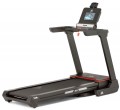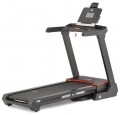Motor power
Power of the motor installed in the electric treadmill (see "Load system"). This parameter is directly related, first of all, to the smoothness of the belt movement and the maximum speed (see above) — the more powerful the motor, the more uniform the movement of the belt will be and the faster it can move. Also, motor power determines the resistance to high loads: with an equal weight category (see "User weight"),
a more powerful model is better suited for people with large body weight, especially at high speeds.
In general, most recreational treadmills have motors between 1.5 and 2.5 hp; more powerful options usually belong to the professional class.
It is worth noting that above we were talking about the constant power of the motor — that is, the power with which it can work for a long time without being subjected to overloads. In some models of treadmills, the so-called peak power — the power that the motor can develop for a short time, for a few seconds. It is higher, but long-term operation at such a load is fraught with the failure of the device. Therefore, before buying, it is worthwhile to clarify, if possible, what power is implied in the specs — nominal or peak; this is especially true for high-power models.
Training programs
The number of
training programs provided for in the design of the simulator. This is not about load levels, but about automatic modes of operation, during which the belt can change the speed of movement, signal the beginning and end of a workout, etc. For details on the number of programs, see Programs and information.
Virtual workout
This function requires the presence of a colour display (see "Features"), and quite a large one. Such a display shows a “picture” that creates the impression that the athlete is not on a stationary treadmill, but is moving along the street, park path, specialized track, etc.; and some models may even provide the ability to connect a larger screen, such as a TV on the wall in front of the machine. At the same time, the speed of virtual movement depends on the intensity of the athlete's work; in other words, the machine determines how fast a person would move in the real world with such an intensity of work, and accordingly adjusts the mode of changing the "picture" on the screen, providing the most realistic image. The main advantage of
virtual workout is obvious: watching the changing landscapes is much more pleasant and interesting than constantly looking at stationary objects. At the same time, it’s not just about positive emotions: additional interest can significantly increase the level of motivation and the overall effectiveness of training. Admittedly, this feature comes at a cost.
More features
—
handlebar control. On the handles of the treadmill are buttons for controlling training modes. Usually, they can be used to adjust the speed of the running belt, as well as stop/start the treadmill. In more advanced machines, buttons can additionally be placed on the handles to adjust the angle of inclination, switch training programs, start/stop the timer, etc.
—
Vibration massager. The treadmill is additionally equipped with a vibration massager with replaceable belts, which is quite rare among such devices. The vibration massager system consists of a stable, height-adjustable stand and a set of special belts. By selecting the necessary belt, program, speed and intensity of work, the user can perform various types of massages: relaxing, corrective, anti-cellulite, etc. During the procedure, the device simultaneously massages the muscles and makes them contract. The vibration massage function is primarily used to correct the figure, warm up the muscles before exercise and relieve fatigue after them.
—
Fan. The treadmill's fan will keep you comfortable during intense workouts, especially in warm weather: the additional air movement increases the evaporation of sweat from the skin, helps cool the body down and prevents overheating.
—
Bottle holder. A special stand that allows you to conveniently place a bo
...ttle of water directly on the simulator. The holder is usually made in such a way that, on the one hand, it is easy to get the bottle, on the other hand, it excludes the possibility of its falling out. This feature will allow you to always have a supply of water on hand and make up for its lack in the body during long workouts, without being distracted from the actual workout and without stopping movement.
— Emergency stop key. The possibility of an emergency stop of the treadmill can significantly increase the safety of training. Usually, an emergency stop key consists of a magnetic contact group, a cable and a clothespin. So, during training, a magnetic key is attached to the control panel of the simulator, a cable is drawn from it (usually less than 1 metre long), and at the end, there is a clothespin that is fixed to the edge of a T-shirt or a belt. If the user stumbles or loses control of the treadmill's speed, the tightness of the cable will simply pull out the magnetic key, which will turn off the motor.
— Colour display. The presence of a colour display in the design of the treadmill. This feature does not affect the main features of the device. However, such displays are considered more convenient and pleasant to view than monochromatic ones. Some models may include various additional features designed to make training more interesting — for example, the ability to play DVD movies or virtual workouts (see above).
— Bluetooth. The presence of a Bluetooth wireless module in the treadmill allows the treadmill to be synchronized with the user's smartphone, tablet or laptop/PC. Thanks to data synchronization, the user will be able to control the results of training in a convenient form. Additionally, Bluetooth wireless communication can be used to download new training programs to the computer of the treadmill and synchronize with the heart rate monitor via the ANT protocol.
— Wi-Fi. The presence of a Wi-Fi wireless communication module in the design of the treadmill. The Wi-Fi interface was originally intended for connecting to computer networks (including Internet access), but more recently it has also been used for direct connection between different devices, without using a network. The specific features implemented using this module may be different. So, some machines can interact with training programs installed on tablets and smartphones and transmit information to such programs about the details of the training (distance travelled, calories burned, etc.), others allow you to update the firmware or change the settings remotely, etc.
— USB port. USB itself is a universal interface designed to connect external peripherals to a computer or other control device. Actually, for the same purpose it is used in modern treadmills; but the specific application in different models may be different. So, USB can be used to connect heart rate sensors and other specialized accessories, to play music and/or video from UDB drives, to update the firmware using the same USB drive, etc.
— TV tuner. The presence in the design of the simulator of a TV tuner — a device designed to receive television broadcasts. This function is useful for those who would like to be able to watch their favourite TV programs, series, etc. in the process of training: usually, models with TV tuners also have colour displays and speakers (see below), which allows you to watch the broadcast directly on the treadmill. However, you need to remember that tuners can be designed for different broadcast standards; therefore, before purchasing a model with this function, it is advisable to make sure that it is compatible with local TV broadcasts.
— mini-jack 3.5 mm (Aux). The 3.5 mm mini-jack (Aux) connector is designed to connect an MP3 player or a smartphone/tablet. This allows you to output the sound signal from multimedia devices to the speakers built into the treadmill. Some models may additionally have a mini-jack connector for connecting headphones. The sound output to the headphones will allow you to train to your favourite music without disturbing other people in the same room.
— Speakers. Through its speakers, the treadmill can play various audio information — service signals (exceeding the heart rate, the end of the program, etc.) or musical compositions and soundtracks of films played on the display (see above).
— Tablet stand. Allows you to securely and safely mount a tablet with almost any screen size on the treadmill. Thanks to this, the user can enjoy watching TV shows or movies directly during training. Usually, the stand is located under the main screen of the treadmill. Advanced class models are often equipped with a stand with the ability to adjust the angle of the tablet. Also, the treadmill can be equipped with a USB port and built-in speakers; some models may have a Wi-Fi wireless module.Dimensions
The dimensions of the treadmill in the assembled state. It is important to note that more space is needed for the comfortable and proper operation of the treadmill.
Weight
The total weight of the treadmill when assembled.
All such treadmills are quite massive — models weighing up to 50 kg are considered
light. And when choosing, it is worth considering that both small and significant weight have their advantages. So, lightweight designs are more convenient when moving, while weighty ones are more stable, often have more extensive functionality, and are also better suited for people with large body weight.

